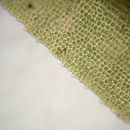Comprehensive Description
provided by North American Flora
Dichodontium pellucidum (I,.) Schimp. Coroll. Bryol
Eur. 12. 1855.
Bryum pellucidum L. Sp. PL 1118. 1753. Bryum Jlavescens Dicks. PI. Crypt. Brit. 2: 4. 1790. Dichodontium Jlavescens Lindb. Bot. Not. 1878: 113. 1878. Dichodontium subjlavescens Kindb.; Roll, Hedwigia 35: 59. ' 1896.
Dioicous : male plants of the same size as the fertile and mixed with them or in separate tufts, the perigonial leaves from a broad, concave base rather abruptly narrowed to a lanceolate point with the costa vanishing below the more or less obtuse or acute apex, the antheridia numerous, more than 0.5 mm. long, with slender paraphyses: plants in small tufts to often extensive mats, yellowish-brown to darkgreen, with radiculose stems 1-10 cm. long, often bearing slender, distantly-leaved innovations from just below the apex: stem-leaves ovatelanceolate or Ungulate to linear-lanceolate, up to about 3.5 mm. long (or in D. pellucidum fagimontanum Brid. pointed-ovate or oblong and mostly 1 mm. or less long), when dry incurvedspreading, somewhat crispate or variously flexuous from an erect base, when moist widely spreading, the broad point keeled, with a rounded or acute apex and flat, not thickened margins, from finely serrulate to coarsely and irregularly serrate (D. pellucidum s erratum Schimp.), the margin in the lower part of the leaf just above the base entire and somewhat farther up more or less recurved on one or both sides ; costa stout, rough on the back in the upper part and vanishing below the apex, in cross-section near the middle showing 4 guide-cells, stereidbands above and below and outer cells differentiated ; upper leaf -cells rather irregular, mostly quadratic and slightly or not elongate, the median ones about 8 by 8-10 m, the lower leaf-cells toward the costa more or less rectangular, 8-10 fj. wide and 20-40 /i long, those toward and in the margin nearly square, the alar cells not differentiated; perichaetial leaves very similar to the stem-leaves but slightly longer with a somewhat broader base: seta erect, yellowish, 1—2 cm. long: capsule oblong, from nearly symmetric and erect to curved and nodding, 1.5— 1.75 mm. long, when dry often showing a short collum and more or less contracted under the broad mouth, with smooth, thick walls and 1 or 2 rows of stomata at the base; annulus none; peristome-teeth up to 80 m wide and more than 400> high, dark-reddish, lanceolate, divided about one half down into mostly 2 forks, finely papillose above, more or less vertically striate on the outer face, from a darker, smooth, basilar membrane extending 2 or 3 rows of cells above the rim of the capsule and attached about the same distance below the rim; lid conic, obliquely rostrate, sometimes about as long as the capsule: calyptra cucullate, entire below, slightly rough at the apex: spores not quite smooth, 18-20 ^ in diameter.
Type ix>cau:ty : Europe.
Distribution: Labrador to New Jersey, westward in the region of the Great Lakes, and from Alaska and Montana to California; also in Europe. Growing in cool, damp places, mostly along
streams, sometimes in water.
- bibliographic citation
- Robert Statham Williams. 1913. (BRYALES); DICRANACEAE, LEUCOBRYACEAE. North American flora. vol 15(2). New York Botanical Garden, New York, NY

